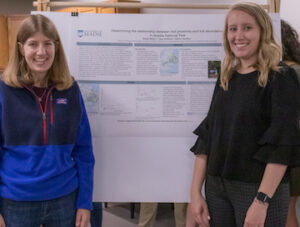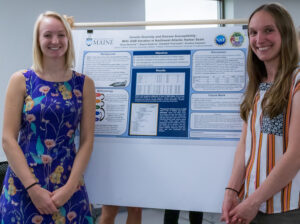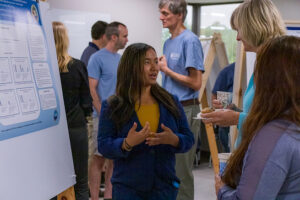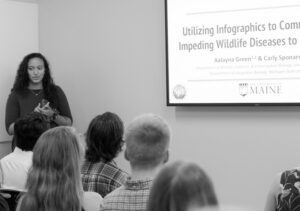Undergraduates from Across the U.S. Join Mitchell Center Faculty for Research Opportunities
Faculty from the Mitchell Center were at the core of this summer’s National Science Foundation-sponsored ‘One Health and the Environment’ summer research program for undergraduates. These competitive ‘Research Experiences for Undergraduates’ programs(REUs) are for undergraduates studying science, engineering, or mathematics and are hosted at various universities.

UMaine received an REU award in early 2019 and this summer hosted ten undergraduates from across the country for a 10-week paid summer research internship titled “Accelerating New Environmental Work skills” (ANEW). The theme implements thinking to solve complex, interdependent problems in human, animal and environmental health.
Four Mitchell Center Faculty Fellows worked with four undergraduate students on a variety of on-going projects. Kristina Cammen (co-principal investigator of the REU), Allison Gardner, Sandra De Urioste-Stone, and Carly Sponarski all participated.
Participating students included Liv Hemond, a rising junior at the University of California at Berkeley,Shayla Miller, a rising junior at Southwestern Oklahoma State University in Weatherford, Oklahoma, Morelys Rodriquez Alfonso, a rising junior student at the University of Puerto Rico at Cayey, and Aalayna Green, a rising junior at Michigan State University.
This summer’s activities built upon UMaine’s recently established“ One Health and the Environment” initiative. Students gain critical research and thinking skills that empower them to tackle complex, interdisciplinary problems at the intersection of human and animal health as well as the health of the environment. The program differs from “health research” in that it emphasizes that a holistic approach to well-being will lead to improved health outcomes and enhanced resilience.
“All of our REU students, including the four advised by Mitchell Center faculty, had an additional mentor along with their faculty mentor,” says Cammen. “These are people who work outside of UMaine, typically in fields related in some way to the student’s research project. The mentors shared the relevance of research to “real-world” problems and helped foster career options in their field.”
Each student also posted a blog about their project. Notes Cammen, “The students wrote their blogs to practice science communication and to share their experience publicly, with friends, family, colleagues, and prospective REU students. Being able to communicate research with members of the general public is a key skill for the students to develop at this point in their professional careers.”

Working with Cammen, an assistant professor of Marine Mammal Science, Liv Hemond’s project involved studying seal DNA to better understand recent trends in seal deaths. While both gray seals and harbor seals live in the waters of the Atlantic, harbor seals are falling ill and dying much more frequently than gray seals. An animal’s DNA contains information about their physical attributes and capabilities, as well as instructions for keeping the animal as healthy as possible. Although Hemond’s research results did not come out quite as planned (see her blog, “Seal of Approval”), she was excited about her research experiences, “I realized how many new concepts and techniques I had learned in the past weeks, and how much more I would learn by continuing the work.”
Shayla Miller joined Allison Gardner, assistant professor ofArthropod Vector Biology, in studying the relationship between tick abundance in Acadia National Park and the trails visitors use. The project integrated data from biological, climate, and social science research to identify ecological, social and cultural factors that influence the risk of human exposure to tick-borne disease. Read more about Miller’s work on her blog “Tick Talk – My Summer at the University of Maine with REU ANEW.” And read Miller’s personal reflection on the project here.

Morelys Rodríguez Alfonso worked with social scientist Sandra De Urioste-Stone, associate professor of Nature-based Tourism, on two linked interdisciplinary projects. She observed how mosquito-borne diseases like the Zika virus are communicated to the public, and how tourists planning to visit Puerto Rico perceived the risks compared to residents of the island.“I joined the project because engaging in opportunities outside my comfort zone is crucial for my interdisciplinary research,” Alfonso says. Read about her work on her blog, “Mosquitoes Brought Me to Maine: Reflections of a One Health REU Student.”

Aalayna Green’s project involved finding the most effective way to communicate potential wildlife diseases of concern to the public. Green worked with Carly Sponarski, assistant professor of Human Dimensions of Wildlife and Fisheries Conservation. Says Green, “When I came across the REU program, and Dr. Sponarski’s research, I knew I had found exactly what I was looking for—a program that would further my own knowledge as well as give me more research experience in finding effective ways to approach these from a One Health perspective.” Read about Green’s project in her blog, “Sick seals, curious mammals, and sneaky leopards, oh my!.”
All ten participating students had the opportunity to present their research results at a One Health ANEW symposium at UMaine on August 8.
